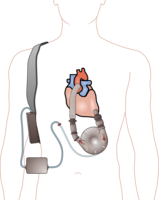
Photo from wikipedia
Myocardial injury induces significant changes in ventricular structure and function at both the cellular and anatomic level, leading to ventricular remodeling and subsequent heart failure. Unloading left ventricular pressure has… Click to show full abstract
Myocardial injury induces significant changes in ventricular structure and function at both the cellular and anatomic level, leading to ventricular remodeling and subsequent heart failure. Unloading left ventricular pressure has been studied in both the short-term and long-term settings, as a means of preventing or reversing cardiac remodeling. In acute myocardial infarction, cardiac unloading is used to reduce oxygen demand and limit infarct size. Research has demonstrated the benefits of short-term unloading with mechanical circulatory support devices before reperfusion in the context of acute myocardial infarction with cardiogenic shock, and a confirmatory trial is ongoing. In chronic heart failure, ventricular unloading using mechanical circulatory support can reverse many of the cellular and anatomic changes that accompany ventricular remodeling. Ongoing research is evaluating the ability of left ventricular assist devices to promote myocardial recovery and remission from clinical heart failure.
Journal Title: Journal of the American College of Cardiology
Year Published: 2018
Link to full text (if available)
Share on Social Media: Sign Up to like & get
recommendations!